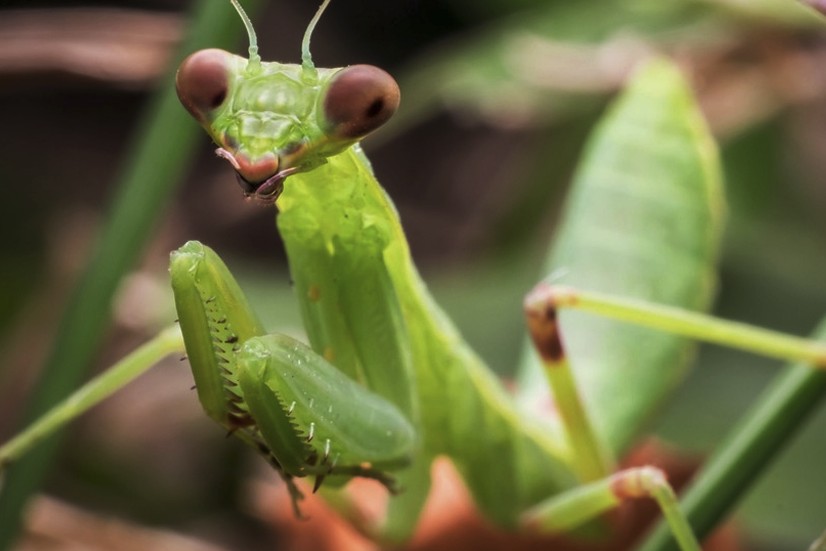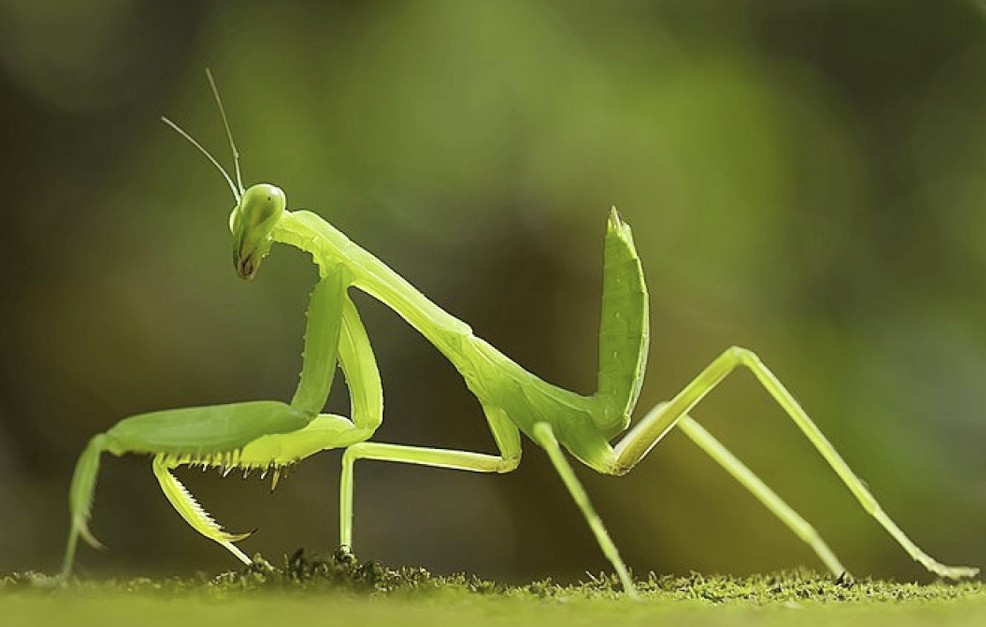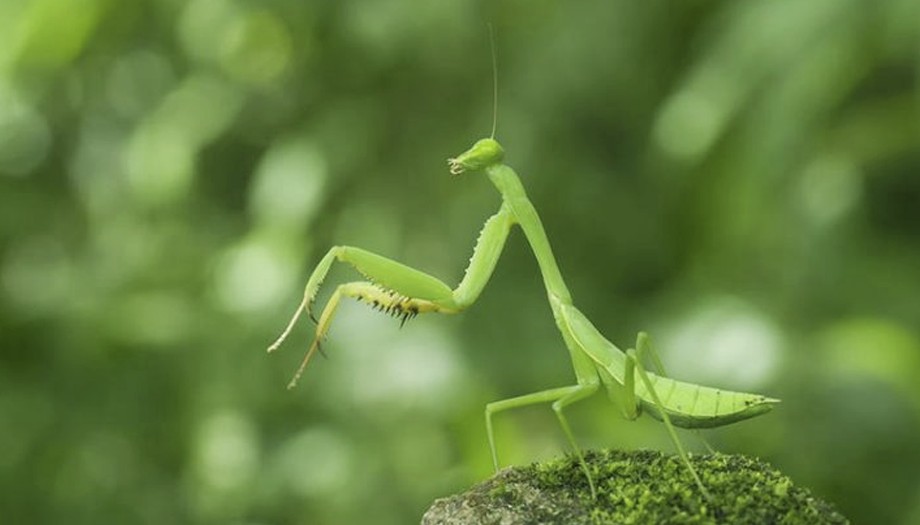Praying Mantis
What is Praying Mantis?
Also known as praying mantids, praying mantises are a lean carnivorous insects that belong to the family ‘Mantidae.’ With more than 2,400 species available in 15 families, the largest family of all is undoubtedly the mantids.

This insect has proven extremely beneficial for humans. But how? Praying mantises feeds on annoying pests. That’s the reason why people express their concerns about having them in the garden. They are well-known for their striking front legs. Their legs are not only inclined but also held together at an angle that suggests the right position of prayer. Praying mantises seem more like impressive predators other than being fascinating creatures.
Is it true that these little green creatures are capable of turning their heads 180 degrees?
Of course yes! Is there any other insect that can easily turn from side to side in a 180-degree angle? Certainly not! Praying mantids are the only ones to do so. This flexibility allows them to see the surroundings using their two large eyes. Truth be told, there are three other eyes which are placed between two large compound eyes.
Praying mantises are usually green or brown in colour. They know how to disguise themselves on the plants among which they dwell. So, their preys have a hard time when it comes to recognizing praying mantis as they have the ability to camouflage themselves on the flora. They make use of their front legs to trap their victim with reflexes so fast that it would be difficult for one to take a glimpse of them with the naked eye.
Appearance and Size

The body of praying mantises is specifically built for capturing their prey. With arms as fast as lightning and whirling head in a triangular shape, these insects have big eyes. These creatures are about 2/5 to 12 inches, and their colors can differ. However, a majority of them can be pea green or brown. If we talk about mantises resembling flowers, they can be found in light colors including pink.
Insects like flies, crickets, moths, and grasshoppers are some insects that catch the attention of praying mantis. Camouflage plays a very crucial role when it comes to the survival of these insects. Due to a number of enemies, praying mantises must know how to merge themselves with the surroundings or habitat. Doing so keeps them safe from being eaten by their predators.
There are some species of praying mantids which has an empty chamber in the body. It has been brought to notice lately that these chambers help mantises to detect bats – one of their most formidable attackers.
Habitat
Not only are praying mantises distributed globally but also in equatorial habitats as well. Different species of these bugs dwell in several parts of continents including:
- North America
- South America
- The Southern Parts of Asia
- Europe
- Some Parts of Australia
- South Africa
Praying mantises, found in the Eastern parts of the United States, can be segregated into the following types:
- The European Mantid (Mantis religiosa),
- Carolina Mantid (Stagmomantis carolina) and
- Chinese Mantid (Tenodera aridifolia sinensis).
There are diverse species that take place in bushes, trees, sandy desert surroundings or grassland. In fact, they can occur in extremely dry systems or wet ecosystems.
What do Praying Mantis Eat?
As mentioned above, the praying mantis is a carnivorous insect which eats other small bugs including beetles, bees, moths, crickets and fruit flies. Feeding on small reptiles, birds and small mammals by praying mantids seems to be a common sight.
Mantises use their ability to blend themselves with the geographical area so that they can gain control over their prey. They wait for the prey to come close enough to be captured. Then they use their front legs for snatching the prey in no time. The front legs are used so that mantids don’t find it hard when it comes to eating their prey.
Behavior and Mating
The mating season for praying mantises takes place in the summer in moderate areas. The female member of the family lays 12-400 eggs in the autumn season. Praying mantises are the ones that will feed on others belonging to their own kind. And what can be the well-known example than the noteworthy mating behavior of the adult female member of the Mantidae family?
There are times when the adult female member of the family practice sexual cannibalism. She will eat her partner after the mating process. Yet this behavior as displayed by the female mantis does not discourage males to indulge in the mating process. Female praying mantis lay several eggs in a small case at regular intervals. Nymphs give birth appearing a lot like miniature versions of their parents.
Praying Mantis Eggs
A praying mantis is an advantageous attacker in the garden because they help a homeowner keep other insect population under control. Thus, it becomes vital for you to recognize their eggs so that you don’t end up causing damage to them unintentionally.
These creatures have made it a common practice to lay their eggs in the garden. Maybe you have seen them and began to wonder what they are. Well, the eggs laid by mantises are not actually eggs but egg cases which are also known as ‘ootheca.’ There are several eggs inside these cases, from 12 to 400 (of course) depending on the praying mantis species. The ootheca keeps the eggs protected till the time they don’t hatch.
Looking to hatch the eggs of the mantis? Then it becomes important for you to make sure that the temperature and humidness in the container must be kept on the right level. The humidity in the air can be kept high when you put substrate on the container’s bottom. Cloth, paper, and white sand are deemed to be good substrates.
Are Praying Mantises Poisonous?
Well, a praying mantis will definitely bite if you provoke the creature, but it does not contain poison. It is important for you to know that a mantis is not an aggressive creature other than being carnivorous. They don’t have an interest in biting humans and no venomous species of praying mantis has been discovered as of yet. However, it does show its lethal behavior when it captures its prey or even when it senses danger around or when attacked by any of its known predators. It includes humans too.
Bite
Even though these critters (praying mantises) are considered dangerous to humans, the latter can still be bitten by the former. The biting behavior of these insects differs with all species. And there’s no denying the bite can be pretty hard.
Humans use creatures for a variety of reasons including crops or in labs for learning purpose. Some people consider these critters as pets. The interesting thing about praying mantis is that it makes use of the spikes on the forelegs to keep itself protected. Their forelegs have sharp thorns. These thorns help them in letting loose a firm grip on their prey. These thorns are like needles which are enough to pierce through one’s skin.
As far as the bite of female praying mantises is concerned, it’s very dangerous for their male partners. Female mantises like to eat their prey alive. They behead the male partner after copulation.
Facts
Here is a list of some of the most interesting facts about praying mantises:
- Praying mantises are energetic like cats
- Praying mantises only prefer eating live food
- They are capable of putting up a fight with bats
- They also have predators
- They engage in unsafe copulation
- They interrupt the food chain
- Praying mantises have excellent vision
- They are gifted as they can camouflage themselves
- Praying mantises were thought to be loaded with special powers.
Pictures
Take a look at some of these pictures of praying mantis:



FAQs
Are they Endangered Species?
A majority of praying mantis species is not endangered. In fact, there are many of them that can be kept as pets. Having them in your garden is the smartest move you will make as they will feed on other insects. There are over 20 species of these critters which are found in North America. None of these species are endangered.
Do Praying Mantis Fly?
One of the most interesting features about praying mantises is that they can fly. However, it all depends on the gender, the weight, the stage of life and ofcourse the species.
Is it Illegal to Kill a Praying Mantis?
Since praying mantises are not protected by the law, killing them does not attract a fine. These pests are not humans or on the endangered species list anymore, they can be killed by humans without lawful consequence.
How Long Do Praying Mantis Live?
A praying mantis usually lives from spring to fall. The longest period this creature will live is around a year.
